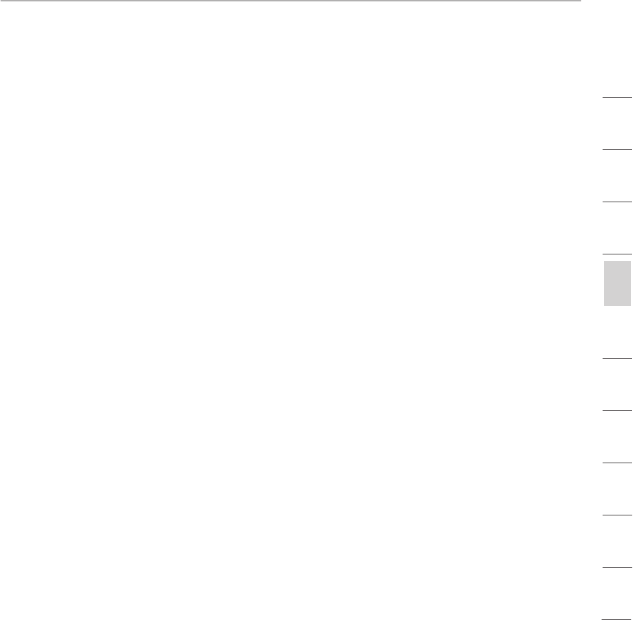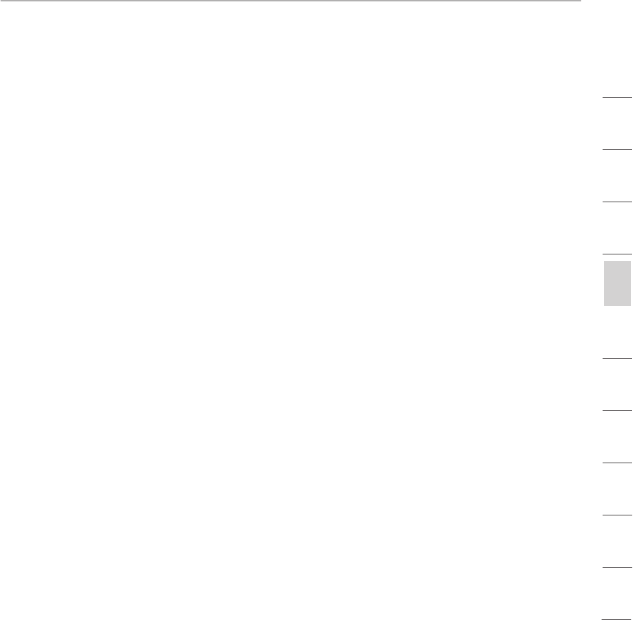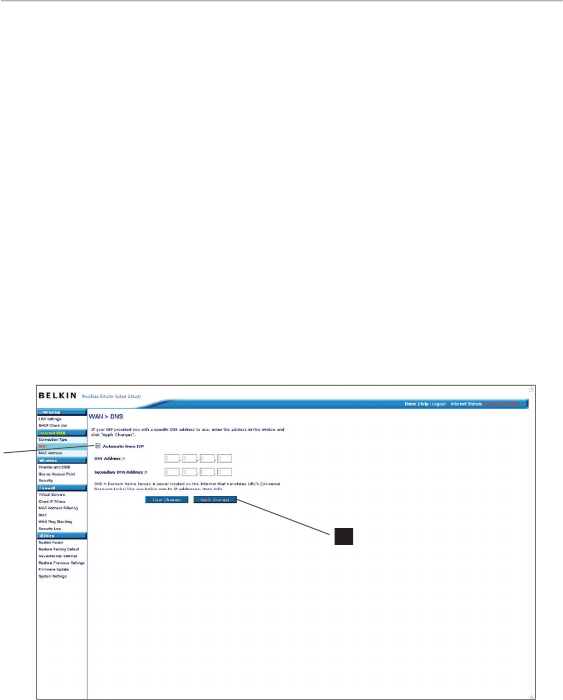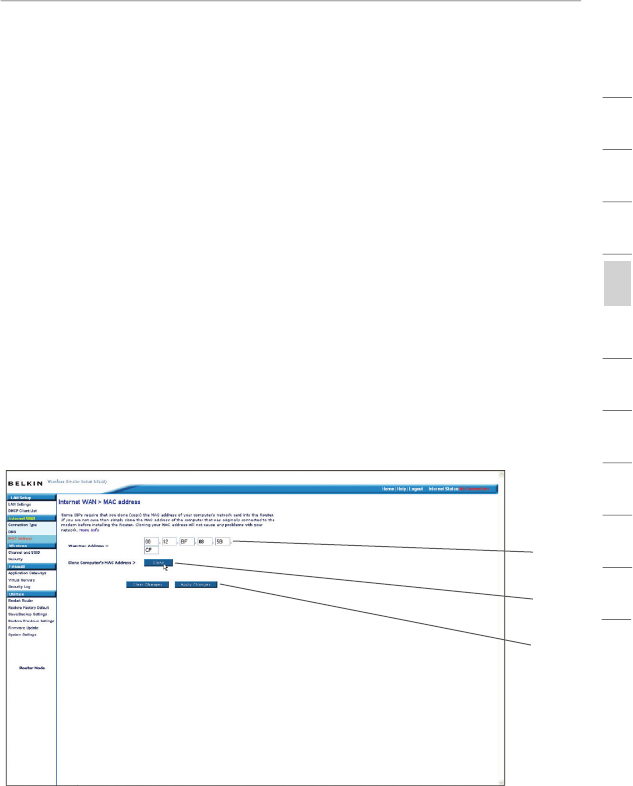Arcadyan Technology WA4001CB WLAN ACCESS POINT User Manual P74841 F5D7233 man indd
Arcadyan Technology Corporation WLAN ACCESS POINT P74841 F5D7233 man indd
Contents
USER MANUAL 3 OF 7

26
Using the Web-Based Advanced User Interface
Using the Web-Based Advanced User Interface
Setting your ISP Connection Type to PPPoE
Most DSL providers use PPPoE as the connection type. If you use a DSL
modem to connect to the Internet, your ISP may use PPPoE to log you into
the service. If you have an Internet connection in your home or small office
that doesn’t require a modem, you may also use PPPoE.
Your connection type is PPPoE if:
1) Your ISP gave you a user name and password, which is required to
connect to the Internet;
2) Your ISP gave you software such as WinPOET or Enternet300 that
you use to connect to the Internet; or
3) You have to double-click on a desktop icon other than your browser
to get on the Internet.
(2)
(1)
(3)
(4)
(5)

Using the Web-Based Advanced User Interface
27
section
2
1
3
4
5
6
7
8
9
10
11
1. User Name
This space is provided to type in your user name that was
assigned by your ISP.
2. Password
Type in your password and re-type it into the “Retype Password”
box to confirm it.
3. Service Name
A service name is rarely required by an ISP. If you are not sure if
your ISP requires a service name, leave this blank.
4. MTU
The MTU setting should never be changed unless your ISP gives
you a specific MTU setting. Making changes to the MTU setting
can cause problems with your Internet connection including
disconnection from the Internet, slow Internet access, and
problems with Internet applications working properly.
5. Maximum Idle Time
The “Maximum Idle Time” feature is used to automatically
disconnect the Router from your ISP when there is no activity
for a specified period of time. For instance, placing a check
mark next to this option and entering “5” into the minute field
will cause the Router to disconnect from the Internet after five
minutes of no Internet activity. This option should be used if you
pay for your Internet service by the minute.

28
Using the Web-Based Advanced User Interface
Using the Web-Based Advanced User Interface
Setting your Internet Service Provider (ISP) Connection Type to
Point-to-Point Tunneling Protocol (PPTP)
[European Countries Only]. Some ISPs require a connection using
PPTP protocol, a type of connection most common in European
countries. This sets up a direct connection to the ISP’s system.
Type in the information provided by your ISP in the space provided.
When you have finished, click “Apply Changes”
(8)
. After you apply
the changes, if your Router is set up properly, the “Internet Status”
indicator will read “Connected”.
1. IP Address
Provided by your ISP. Enter the IP address here.
2. Subnet Mask
Provided by your ISP. Enter your subnet mask here.
3. Default Gateway
Provided by your ISP. Enter your default gateway here.
4. User ID
Provided by your ISP. Enter your PPTP account name here.
(1)
(2)
(3)
(4)
(5)
(6)
(7)
(8)

Using the Web-Based Advanced User Interface
29
section
2
1
3
4
5
6
7
8
9
10
11
5. Password
Type your password here. Then retype it into the “Retype
Password” box.
6. PPTP Default Gateway
Provided by your ISP. Enter your service IP address here.
7. Idle Time Out
The “Maximum Idle Time” feature is used to automatically disconnect
the Router from your ISP when there is no activity for a specified
period of time. For instance, if you place a check mark next to
this option and enter “5” into the minute field, the Router will
disconnect from the Internet after five minutes of no Internet
activity. This option should be used if you pay for your Internet
service by the minute. This feature also allows you to select
“manual connect”, “auto connect”, and “keep session” options.

30
Using the Web-Based Advanced User Interface
Using the Web-Based Advanced User Interface
Setting Custom Domain Name Server (DNS) Settings
A “Domain Name Server” is a server located on the Internet that
translates Universal Resource Locators (URLs) like “www.belkin.com”
into IP addresses. Many Internet Service Providers (ISPs) do not require
you to enter this information into the Router. The “Automatic from ISP”
box
(1)
should be checked if your ISP did not give you a specific DNS
address. If you are using a static IP connection type, then you may
need to enter a specific DNS address and secondary DNS address for
your connection to work properly. If your connection type is dynamic
or PPPoE, it is likely that you do not have to enter a DNS address.
Leave the “Automatic from ISP” box checked. To enter the DNS address
settings, uncheck the “Automatic from ISP” box and enter your DNS
entries in the spaces provided. Click “Apply Changes”
(2)
to save
the settings.
Configuring your WAN Media Access Controller (MAC) Address
All network components including cards, adapters, and routers, have
a unique “serial number” called a MAC address. Your Internet Service
Provider may record the MAC address of your computer’s adapter
and only let that particular computer connect to the Internet service.
When you install the Router, its own MAC address will be “seen”
by the ISP and may cause the connection not to work. Belkin has
provided the ability to clone (copy) the MAC address of the computer
into the Router. This MAC address, in turn, will be seen by the ISP’s
(2)
(1)

Using the Web-Based Advanced User Interface
31
section
2
1
3
4
5
6
7
8
9
10
11
system as the original MAC address and will allow the connection to
work. If you are not sure whether your ISP needs to see the original
MAC address, simply clone the MAC address of the computer that
was originally connected to the modem. Cloning the address will not
cause any problems with your network.
Cloning your MAC Address
To clone your MAC address, make sure that you are using the
computer that was ORIGINALLY CONNECTED to your modem before
the Router was installed. Click the “Clone” button
(1)
. Click “Apply
Changes”
(3)
. Your MAC address is now cloned to the Router.
Entering a Specific MAC Address
In certain circumstances you may need a specific WAN MAC address.
You can manually enter one in the “MAC Address” page. Type in a
MAC address in the spaces provided
(2)
and click “Apply
Changes”
(3)
to save the changes. The Router’s WAN MAC address
will now be changed to the MAC address you specified.
(1)
(2)
(3)

32
Using the Web-Based Advanced User Interface
Using the Web-Based Advanced User Interface
Viewing LAN Settings
Clicking on the header of the “LAN Setup” tab
(1)
will take you to its
header page. A quick description of the functions can be found here.
To view the settings or make changes to any of the LAN settings, click
on “LAN Settings”
(2)
or to view the list of connected computers,
click on “DHCP Client List”
(3)
.
(1)
(2)
(3)

Using the Web-Based Advanced User Interface
33
section
2
1
3
4
5
6
7
8
9
10
11
Changing LAN Settings
All settings for the internal LAN setup of the Router can be viewed
and changed here.
1. IP Address
The “IP address” is the internal IP address of the Router. The
default IP address is “192.168.2.1”. To access the Web-Based
Advanced User Interface, type this IP address into the address
bar of your browser. This address can be changed if needed.
To change the IP address, type in the new IP address and click
“Apply Changes”. The IP address you choose should be a
non-routable IP.
Examples of a non-routable IP are:
192.168.x.x (where x is anything between 0 and 255), and
10.x.x.x (where x is anything between 0 and 255).
2. Subnet Mask
There is no need to change the subnet mask. This is a unique,
advanced feature of your Belkin Router. It is possible to change
the subnet mask if necessary; however, do
NOT
make changes to
the subnet mask unless you have a specific reason to do so. The
default setting is “255.255.255.0”.
(1)
(2)
(3)
(4)
(6)
(5)

34
Using the Web-Based Advanced User Interface
Using the Web-Based Advanced User Interface
3. DHCP Server
The DHCP server function makes setting up a network very easy
by assigning IP addresses to each computer on the network
automatically. The default setting is “On”. The DHCP server
can be turned OFF if necessary; however, in order to do so you
must manually set a static IP address for each computer on
your network. To turn off the DHCP server, select “Off” and click
“Apply Changes”.
4. IP Pool
The range of IP addresses set aside for dynamic assignment to the
computers on your network. The default is 2–100 (99 computers). If
you want to change this number, you can do so by entering a new
starting and ending IP address and clicking on “Apply Changes”.
The DHCP server can assign 100 IP addresses automatically. This
means that you cannot specify an IP address pool larger than 100
computers. For example, starting at 50 means you have to end at
150 or lower so as not to exceed the 100-client limit. The starting
IP address must be lower in number than the ending IP address.
5. Lease Time
The length of time the DHCP server will reserve the IP address
for each computer. We recommend that you leave the lease
time set to “Forever”. The default setting is “Forever”, meaning
that any time a computer is assigned an IP address by the
DHCP server, the IP address will not change for that particular
computer. Setting lease times for shorter intervals such as one
day or one hour frees IP addresses after the specified period of
time. This also means that a particular computer’s IP address
may change over time. If you have set any of the other advanced
features of the Router such as DMZ or client IP filters, these are
dependent on the IP address. For this reason, you will not want
the IP address to change.
6. Local Domain Name
The default setting is “Belkin”. You can set a local domain name
(network name) for your network. There is no need to change this
setting unless you have a specific advanced need to do so. You can
name the network anything you want such as “MY NETWORK”.

Using the Web-Based Advanced User Interface
35
section
2
1
3
4
5
6
7
8
9
10
11
Viewing the DHCP Client List Page
You can view a list of the computers (known as clients), which are
connected to your network. You are able to view the IP address
(1)
of
the computer, the host name
(2)
(if the computer has been assigned
one), and the MAC address
(3)
of the computer’s network interface
card (NIC). Pressing the “Refresh”
(4)
button will update the list. If
there have been any changes, the list will be updated.
(1)
(2)
(3)
(4)

36
Using the Web-Based Advanced User Interface
Using the Web-Based Advanced User Interface
Configuring the Wireless Network Settings
The “Wireless” tab lets you make changes to the wireless network
settings.
From this tab, you can make changes to the wireless network
name (SSID), operating channel, and encryption security settings. You
can also configure the Router to be used as an access point.
(1)
(2)
Changing the Wireless Network Name (SSID)
To identify your wireless network, a name called the SSID (Service Set
Identifier) is used. The default SSID of the Router is “Belkin Traveler”.
You can change this to a name of your choice or leave it unchanged.
If there are other wireless networks operating in your area, you will
want to make sure that your SSID does not match that of another
wireless network in the area. To change the SSID, type the SSID that
you want to use in the “SSID” field
(1)
and click “Apply Changes”
(2)
. The change will be effective immediately. If you make a change
to the SSID, your wireless-equipped computers may also need to be
reconfigured to connect to your newly named network. Refer to the
documentation of your wireless network adapter for information on
making this change.

Using the Web-Based Advanced User Interface
37
section
2
1
3
4
5
6
7
8
9
10
11
Securing your Wi-Fi
®
Network
Here are a few different ways you can maximize the security of your
wireless network and protect your data from prying eyes and ears.
This section is intended for the home, home office, and small office
user. At the time of this User Manual’s publication, there are three
encryption methods available.
Name
64-bit Wired
Equivalent
Privacy
128-bit Wired
Equivalent
Privacy
Wi-Fi Protected
Access-TKIP
Wi-Fi Protected
Access-AES
Acronym
64-bit WEP
128-bit WEP
WPA-TKIP
WPA-AES
Security
Good
Better
Best
Best
Features
Static keys
Static keys
Dynamic key
encryption
and mutual
authentication
Dynamic key
encryption
and mutual
authentication
Encryption
keys based
on RC4
algorithm
(typically
40-bit keys)
More secure
than 64-bit
WEP using a
key length of
104 bits plus
24 additional
bits of system-
generated data
TKIP (temporal
key integrity
protocol)
added so
that keys are
rotated and
encryption is
strengthened
AES (Advanced
Encryption
Standard)
does not
cause any
throughput loss
WEP (Wired Equivalent Privacy)
WEP (Wired Equivalent Privacy) is a common protocol that adds
security to all Wi-Fi-compliant wireless products. WEP was designed
to give wireless networks the equivalent level of privacy protection as
a comparable wired network.
64-Bit WEP
64-bit WEP was first introduced with 64-bit encryption, which
includes a key length of 40 bits plus 24 additional bits of
system-generated data (64 bits total). Some hardware manufacturers
refer to 64-bit as 40-bit encryption. Shortly after the technology was
introduced, researchers found that 64-bit encryption was too easy
to decode.